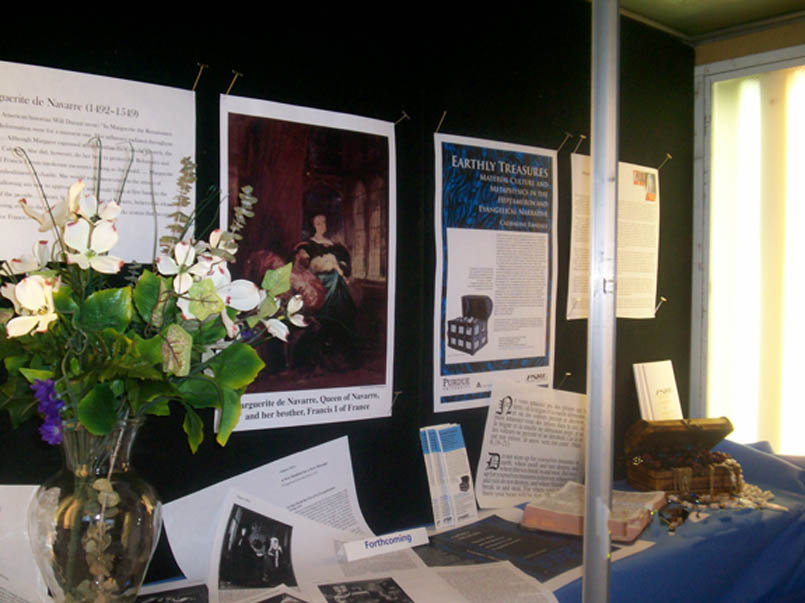Earthly Treasures: Material Culture and Metaphysics in the Heptaméron and Evangelical Narrative
Catherine Randall
Earthly Treasures maps the presence, position, and use in the narrative of a variety of material objects in Marguerite de Navarre's Heptaméron. Featured in the text is a wide selection of objects, ranging from tapestries with scripture passages woven into the borders, fine arts paintings, and chalices incised with proverbs, to emblems, table linens, Bibles or manuscripts, clothing, masks, stage props, jewelry, furniture, and foodstuffs. Although the presence of such material objects seems paradoxical, given the scriptural mandate to disregard things of this world, and to "store up treasure" in heaven instead, Marguerite found license to use such objects both in the Bible and in Martin Luther’s Table Talk.
Marguerite, sister of the Renaissance collector king François Ier, was surrounded by beautiful and costly objects, and she used them in her narrative to highlight the disparity between life as it is and, in a theological sense, life as it should be. Because of her social standing, she influenced other evangelical writers (such as Bonaventure Des Périers and Jacques Yver) to use material objects similarly: as concrete, iconic arrows both indicting worldliness and pointing the way out of the world.
The Heptaméron has not formerly been read as the model for, and progenitor of, a new way of treating the world from an evangelical standpoint. This innovative approach is predicated on an acknowledgment of the plethora of material objects adorning the early modern universe, as well as the cultivation of an attitude of suspicion about the circumstances of their production, the potential for distortion, and the need for the fallen world to be, in a truly Protestant project, realigned with its scriptural template.
“In addition to the scholarship and the vast scope of its research, this book offers an unexplored facet of the Heptaméron and of Marguerite de Navarre’s thought.” —Regine Reynolds-Cornell, who has written extensively on the work of Marguerite de Navarre
"Catharine Randall's volume ... offers the reader a significant and provocative perspective on Marguerite and her story collection. ... the notes to the volume are extensive and often contain not-to-be missed information. Happily Randall (or her editor) had the kindness to head each page of footnotes with the span of pages in the text where the notes appear ... Randall leaves the reader believing that no detail in the Heptaméron is extraneous and that every object has an ideological purpose." Megan Conway, Sixteenth Century Journal 40.2 (Summer 2009): 593-95.
"... quite a welcome contribution to the corpus of Marguerite criticism. The research Randall has put into this book is impressive. ... The richness ... makes it well worth reading." Kathleen Perry Long, French Studies 63.2 (2009): 205.
"This volume gives a solid overview of key elements of Reformist thought with particular attention to Luther's development of evangelical narrative. ... While Earthly Treasures is interdisciplinary in nature, it is also an extremely specialized work that will be of greatest benefit to specialists of Marguerite de Navarre and scholars whose main interest is the intersection between religion and literature in sixteenth-century France."Leanna Bridge Rezvani, Renaissance Quarterly 61.3 (Fall 2008): 902-03.
For further reviews, see:
The Chronicle of Higher Education June 22, 2007.
Reference & Research Book News Aug. 2007.
Catharine Randall, Fordham University, is the author of five books and some fifty articles and book chapters. Her current project is a book-length study of the Huguenots and Camisards in the seventeenth and eighteenth centuries. A book manuscript about the Huguenots and Camisards in the seventeenth and eighteenth centuries entitled From a Far Country is currently under review, and her latest project is an updated edition of a selection of the Jesuit Relations entitled Going in by Their Door for Fordham University Press. Her professional career has been oriented around exploring the constraints that varieties of Protestantism imposed on writers of particular confessions (such as Calvinism or Lutheranism) as well as the permissions for artistic expression that—somewhat surprisingly—may be discerned in those theological systems.
ISBN-13: 978-1-55753-449-1
2007. Vol. 40. x, 354 pp. Paper $43.95
Window display in Stanley Coulter Hall, April 16-23, 2007.